If you want to grant access permissions on items such as clusters, indexes, and fields, you can use the role-based access control (RBAC) mechanism that is provided by the X-Pack plug-in of Elasticsearch. This mechanism allows you to grant permissions to custom roles and assign the roles to users to implement access control. Elasticsearch provides a variety of built-in roles. You can create custom roles based on the built-in roles to meet your business requirements. This topic describes how to create and configure a custom role to implement access control.
Background information
- Elasticsearch supports the RBAC mechanism that is provided by the X-Pack plug-in. For more information, see User authorization.
- Elasticsearch supports various security authentication features. For more information, see Identity authentication and authorization in Elasticsearch.
Procedure
- Create a role.
- Create a user and assign the role to the user.
- Log on to the Kibana console as the user and perform operations to check whether the user has the related permissions.
Configure read-only permissions on indexes
Scenario
Grant the read-only permissions on a specific index to a common user. In this case, the user can be used to query data from the index in the Kibana console but cannot access clusters.
Role configuration
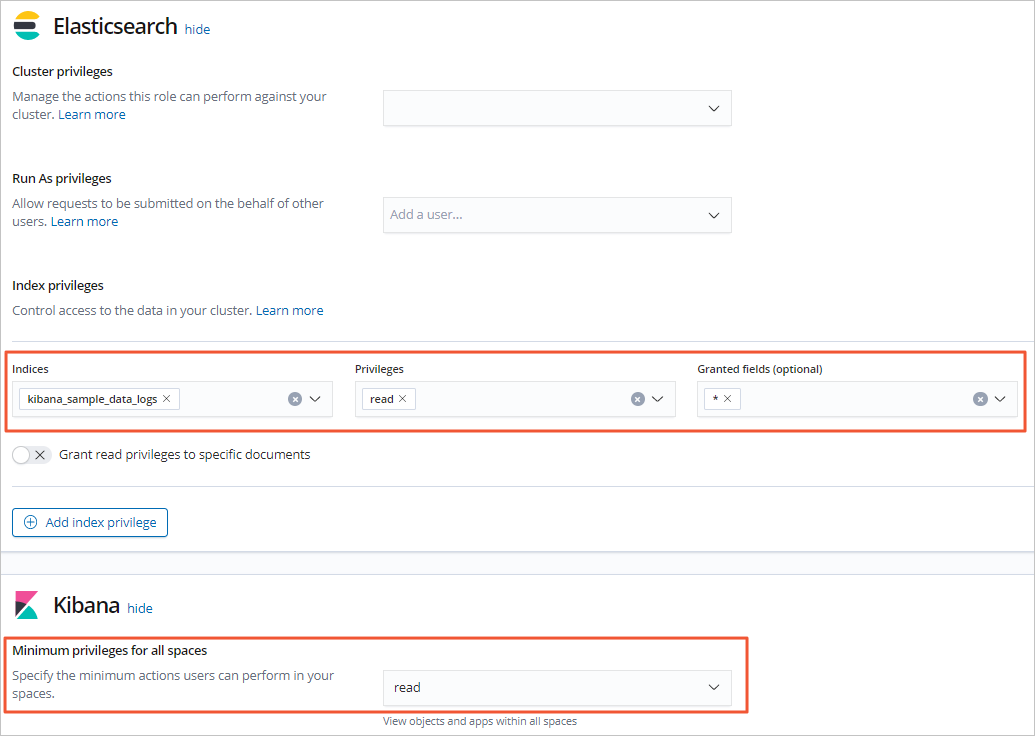
| Permission type | Permission key | Permission value | Description |
|---|---|---|---|
| Index privileges | indices | kibana_sample_data_logs | The name of the index. You can specify a full index name, alias, wildcard, or regular expression. For more information, see Indices privileges. |
| privileges | read | The read-only permissions on the indexes. The read-only permissions include the permissions to call the count, explain, get, mget, scripts, search, and scroll APIs. For more information, see privileges-list-indices. | |
| Granted fields (optional) | * | The fields on which you want to grant permissions. The value * indicates all fields. | |
| Kibana privileges | privileges | read | The read-only permissions on Kibana. The permissions are granted to all spaces. Default value: none. This value indicates that no spaces are authorized to access Kibana. Important Versions earlier than Kibana V7.0 support only base privileges. Kibana V7.0 and later support base privileges and feature privileges. After you assign a base privilege to a role, the role has access permissions on all Kibana spaces. After you assign a feature privilege to a role, the role has access permissions only on a specific feature. When you assign a feature privilege, you must specify a Kibana space. |
Verification
- Log on to the Kibana console as the common user and run an index read command. The system returns results as expected.
GET /kibana_sample_data_logs/_search - Run an index write command. The system returns an error message. The message indicates that the user is not authorized to perform write operations.
POST /kibana_sample_data_logs/_doc/1 { "productName": "testpro", "annual_rate": "3.22%", "describe": "testpro" }
Configure operation permissions on dashboards
Scenario
Grant the read-only permissions on a specific index and the permissions to view the dashboards for the index to a common user.
Role configuration
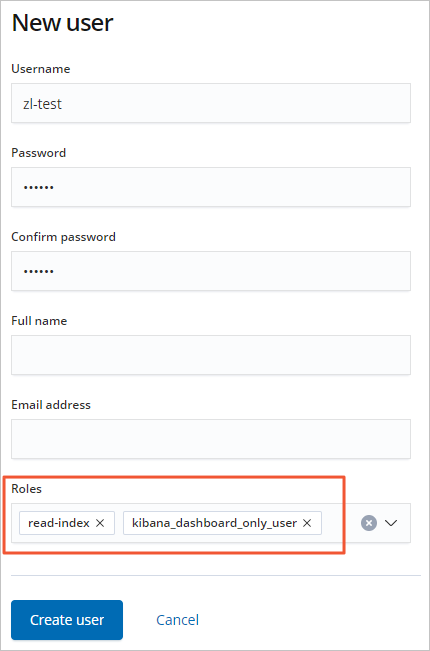
- read-index: a custom role. You must manually create the role. This role has read-only permissions on the specific index.
- kibana_dashboard_only_user: a Kibana built-in role. This role has the permissions to view the dashboards for the index. Note
- In Kibana V7.0 and later, the kibana_dashboard_only_user role is deprecated. If you want to view the dashboards for a specific index, you need to only configure the read-only permissions on the index. For more information, see Configure read-only permissions on indexes.
- The kibana_dashboard_only_user role can be used with custom roles in various scenarios. If you want to configure the Dashboards only roles feature only for a custom role, perform the following steps: In the Kibana section of the Management page, click Advanced Settings. Then, in the Dashboard section of the page that appears, set the Dashboards only roles parameter to the custom role. The default value of this parameter is kibana_dashboard_only_user.
Verification
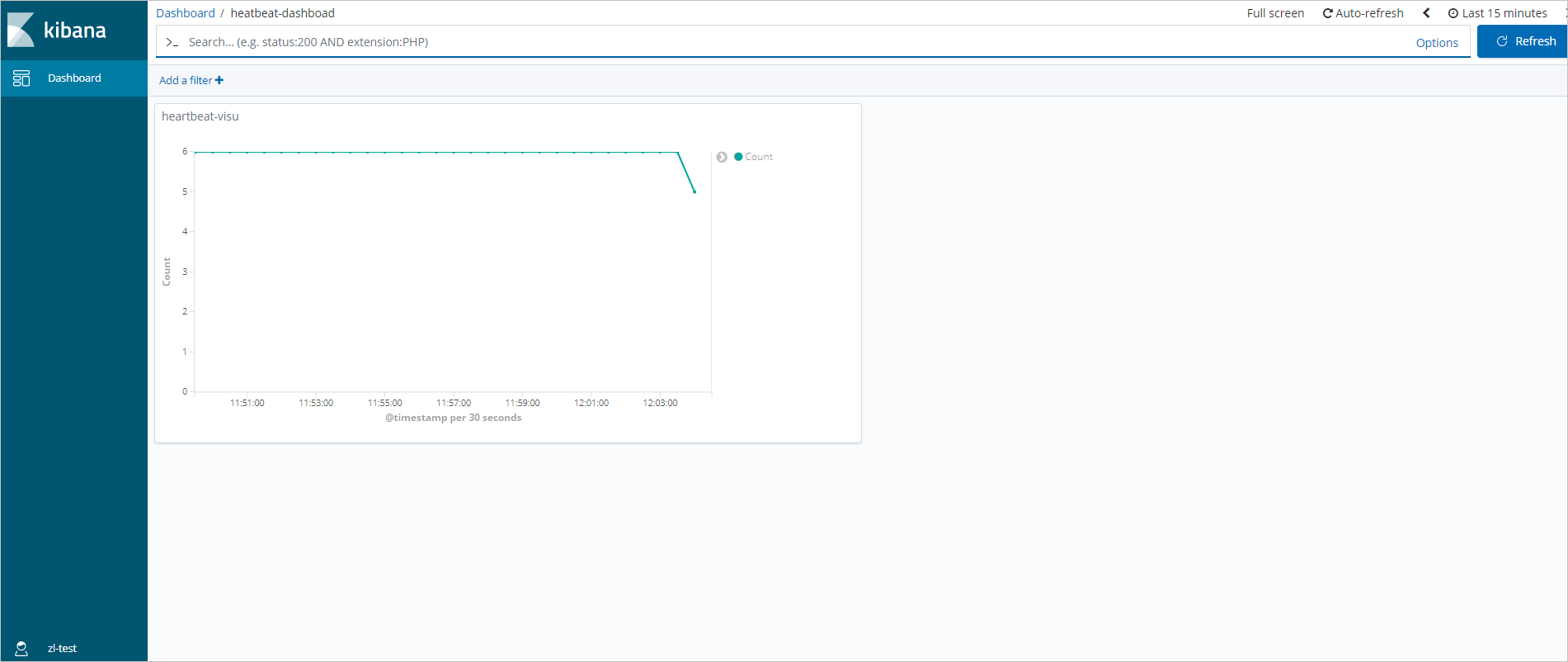
Configure read and write permissions on indexes and read-only permissions on your cluster
Scenario
Grant the read, write, and delete permissions on specific indexes and the read-only permissions on your cluster and Kibana to a common user.
Role configuration
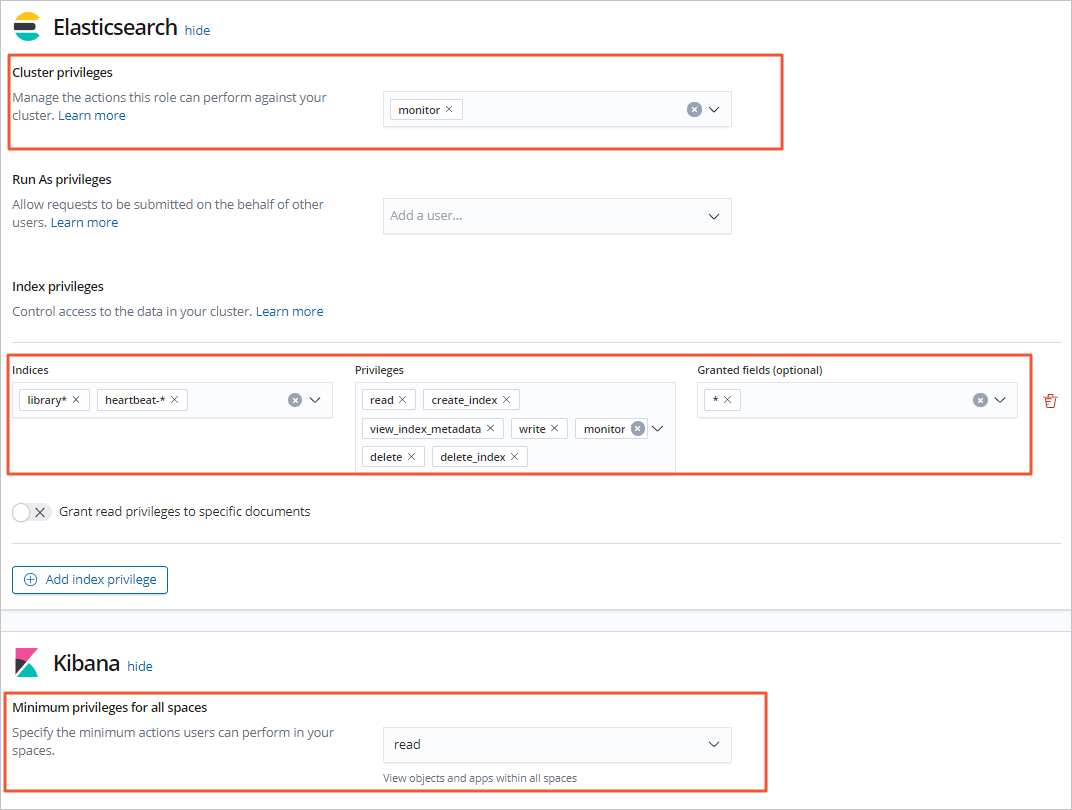
| Permission type | Permission key | Permission value | Description |
|---|---|---|---|
| Cluster privileges | cluster | monitor | The read-only permissions on the cluster, such as the permissions to view the running status, health status, hot threads, node information, and blocked tasks of the cluster. |
| Index privileges | indices | heartbeat-*,library* | The names of the indexes. You can specify a full index name, alias, wildcard, or regular expression. For more information, see roles-indices-privileges. |
| privileges | read | The read-only permissions on the indexes. The read-only permissions include the permissions to call the count, explain, get, mget, scripts, search, and scroll APIs. For more information, see privileges-list-indices. | |
| create_index | The permission to create indexes. If you want to specify an alias for an index when you create the index as the user, you must grant the manage permission to the user. Important The alias must meet the matching rules that are defined by the Indices parameter. | ||
| view_index_metadata | The read-only permissions on index metadata. The permissions include the permissions to call the following APIs: aliases, aliases exists, get index, exists, field mappings, mappings, search shards, type exists, validate, warmers, settings, and ilm. | ||
| write | The permission to perform all write operations on documents. The operations include mapping updates and the operations that are performed by calling the index, update, delete, or bulk API. The write permission involves more operation permissions than the create and index permissions. | ||
| monitor | The permission to monitor all operations. The operations include the operations that are performed by calling the index recovery, segments info, index stats, or status API. | ||
| delete | The permission to delete documents. | ||
| delete_index | The permission to delete indexes. | ||
| granted fields | * | The fields on which you want to grant permissions. The value * indicates all fields. | |
| Kibana privileges | privileges | read | The read-only permissions on Kibana. The permissions are granted to all spaces. Default value: none. This value indicates that no spaces are authorized to access Kibana. Important Versions earlier than Kibana V7.0 support only base privileges. Kibana V7.0 and later support base privileges and feature privileges. After you assign a base privilege to a role, the role has access permissions on all Kibana spaces. After you assign a feature privilege to a role, the role has access permissions only on a specific feature. When you assign a feature privilege, you must specify a Kibana space. |
Verification

- View the details about indexes in the cluster
GET /_cat/indices?v - View the status of the cluster
GET /_cluster/stats - Query data in the product_info index
GET /product_info/_search - Query data in the product_info1 index
GET /product_info1/_search - Use a POST request to write data to the kibana_sample_data_logs index
POST /kibana_sample_data_logs/_doc/2 { "productName": "testpro", "annual_rate": "3.22%", "describe": "testpro" } - Use a PUT request to write data to the product_info2 index
PUT /product_info2/_doc/1 { "productName": "testpro", "annual_rate": "3.22%", "describe": "testpro" } - Delete the product_info index
DELETE product_info
Configure read-only permissions on the Discover page and a specific index
Scenario
Grant the read-only permissions on the Discover page of the Kibana console and the read-only permissions on a specific index to a common user. This way, the user can be used to view the data in the index on the Discover page.
Role configuration
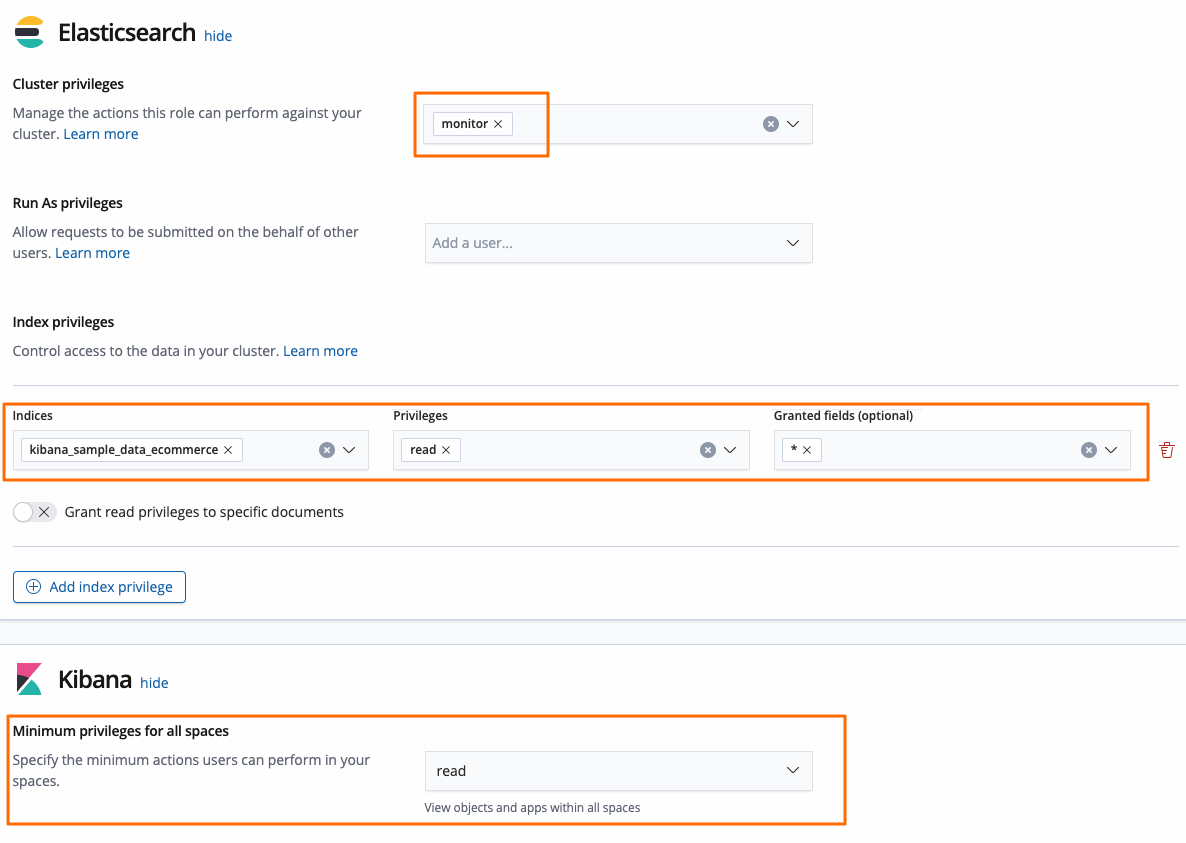
| Permission type | Permission key | Permission value | Description |
|---|---|---|---|
| Cluster privileges | Privileges | monitor | The read-only permissions on your cluster, such as the permissions to view the running status, health status, hot threads, node information, node and cluster statistics, and blocked tasks of the cluster. |
| Index privileges | Indices | kibana_sample_data_ecommerce | The name of the index. You can specify a full index name, alias, wildcard, or regular expression. For more information, see Indices privileges. |
| Privileges | read | The read-only permissions on the index. The read-only permissions include the permissions to call the count, explain, get, mget, scripts, search, and scroll APIs. For more information, see privileges-list-indices. | |
| Granted fields (optional) | * | The fields on which you want to grant permissions. The value * indicates all fields. | |
| Kibana privileges | Privileges | read | The read-only permissions on Kibana. The permissions are granted to all spaces. Default value: none. This value indicates that no spaces are authorized to access Kibana. Important Versions earlier than Kibana V7.0 support only base privileges. Kibana V7.0 and later support base privileges and feature privileges. After you assign a base privilege to a role, the role has access permissions on all Kibana spaces. After you assign a feature privilege to a role, the role has access permissions only on a specific feature. When you assign a feature privilege, you must specify a Kibana space. For example, when you assign the read-only permissions on the Discover page of the Kibana console, you must specify a Kibana space. |
Verification

Configure permissions to create and delete indexes, modify index configurations, and add, remove, modify, and query documents
Scenario
Grant the permissions to create and delete indexes, modify index configurations, and add, remove, modify, and query documents to a common user. In addition, prohibit the user from logging on to the Kibana console.
Role configuration

| Permission type | Permission key | Permission value | Description |
|---|---|---|---|
| Index privileges | Indices | test* | The names of the indexes. You can specify a full index name, alias, wildcard, or regular expression. For more information, see Indices privileges. |
| Privileges | create_index | The permission to create indexes. If you want to specify an alias for an index when you create the index as the user, you must grant the manage permission to the user. | |
| delete_index | The permission to delete indexes. | ||
| index | The permission to index documents, update documents, and update index mappings. | ||
| delete | The permission to delete documents. | ||
| read | The read-only permissions on indexes. The read-only permissions include the permissions to call the count, explain, get, mget, scripts, search, and scroll APIs. For more information, see privileges-list-indices. | ||
| manage | The permission to manage indexes. The management operations that you can perform include the operations that are performed by calling the aliases, analyze, cache clear, close, delete, exists, flush, mapping, open, force merge, refresh, settings, search shards, templates, or validate API. | ||
| Granted fields (optional) | * | The fields on which you want to grant permissions. The value * indicates all fields. | |
| Kibana privileges | Privileges | none | The default value of this parameter is none. This value indicates that no spaces are authorized to access Kibana. Important Versions earlier than Kibana V7.0 support only base privileges. Kibana V7.0 and later support base privileges and feature privileges. After you assign a base privilege to a role, the role has access permissions on all Kibana spaces. After you assign a feature privilege to a role, the role has access permissions only on a specific feature. When you assign a feature privilege, you must specify a Kibana space. |
Verification
- Access your cluster, create an index in the cluster, and delete the index.

- Modify the configurations of an index. In this example, the data in the index is specified as cold data.

- Add, remove, modify, and query documents.

- Log on to the Kibana console. The system prompts that the user does not have the required permissions.

 icon in the upper-left corner and choose
icon in the upper-left corner and choose 
